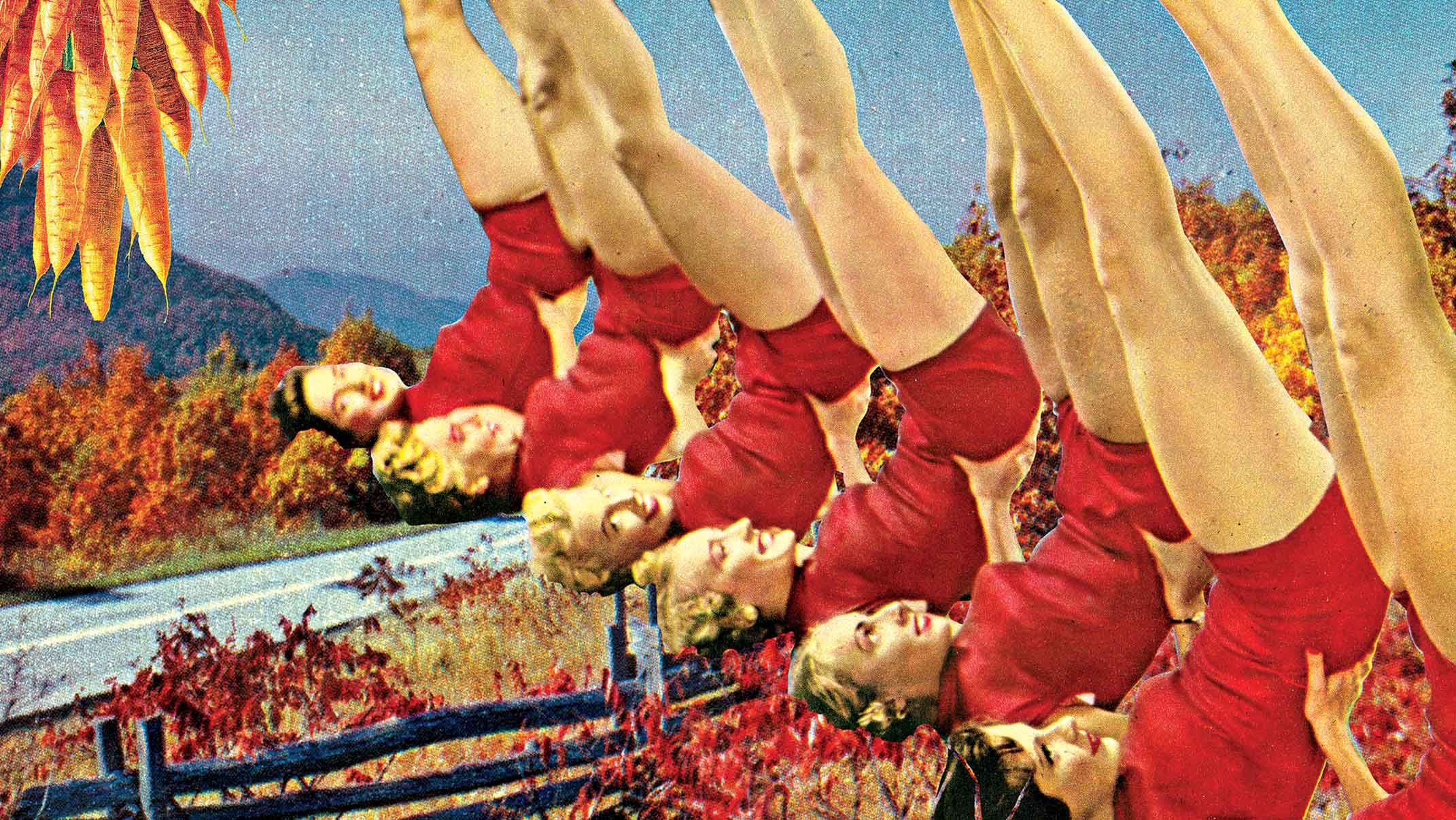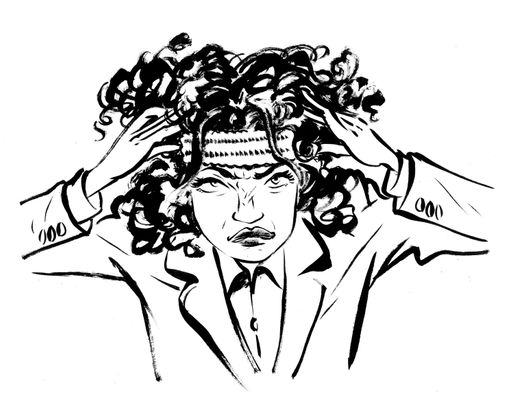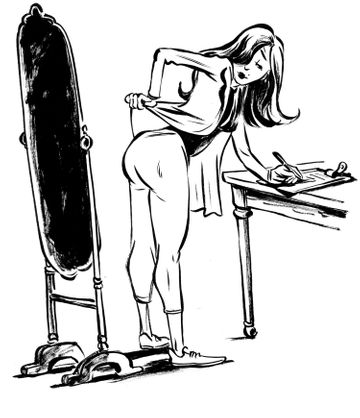
1.
I Tried a “Smart” Kegel Trainer
By Anonymous**See orgasm confession below.
The benefits of pelvic-floor strengthening (a.k.a. Kegel exercises) are said to be many, including reduced incontinence and increased vaginal stimulation. Apparently, though, there’s a wrong way to do them. That’s where the vibratorlike kGoal trainer comes in, monitoring (with, yes, another mobile app) which muscles are engaged and how effectively and often you’re engaging them, and offering a series of “workouts” to whip that vagina into shape.
Step 1: Insert the bulbous portion of the claw-shaped silicone kGoal in your person, while the “control arm” rests on your pubic area. I found the best position was lying down on my back with my legs in a gentle butterfly position. And do use the included packet of lube — losing my kGoal virginity was probably more uncomfortable than losing my actual virginity.
Step 2: Push a button on the arm to sync via Bluetooth with your iPhone or Android.
Step 3: Start the five-minute workout with a ten-second calibration exercise, activating the pelvic-floor muscles so the device can detect them.
Step 4: Follow the app through multiple rounds of three types of exercises — a sustained hold challenging your endurance; a slow back and forth, during which contractions must match the speed and level of a control line; and a rapid pulsing of the muscles, also in time with the app. The device’s vibrations vary depending on whether you’re squeezing the correct way, with the pelvic floor, or making the common mistake of just using your glutes. (The sensation is like using an ineffective vibrator: It brings you to the brink of orgasm without delivering.)
Step 5: Read your score, rating a composite of your strength, control, and endurance on a scale of zero to ten. The first time, mine was a paltry 4.9; by day three, I’d improved to a 7.9. Though there weren’t any immediate benefits — I haven’t recently had a baby and don’t struggle with incontinence — I did discover how to hack your kGoal so it doubles as a vibrator. Just lift your hips like you’re doing a glute bridge, which activates a sustained vibration. Engaging your pelvic-floor muscles controls the intensity, and … yep, well worth the $149.

2.
I Showered Only Once a Week
By Melissa Dahl
Your daily shower is bad for you, or so goes the argument of dermatologists who say too-frequent ablutions rob the skin of moisture and kill off its protective layer of good bacteria. But will showering less (sticking to spot-cleaning only) leave me a greasy, smelly mess? Here, five results of my very French month.
(1) My body temperature felt permanently elevated on the days I didn’t shower, just below being uncomfortably warm. It’s not clear exactly why this was happening, but Joshua Zeichner, a dermatologist at Mount Sinai hospital, has a theory, and it is disgusting. Our bodies maintain a comfortable core temperature by sweating; evaporation of that sweat is what keeps us cool. “Maybe accumulation of dirt, oil, pollution, and sunscreen on the skin blocked normal sweating, making you feel hot,” Zeichner suggested.
(2) Day one of not showering felt pretty much the same as day five, a sensation backed by science: Elaine Larson, associate dean for research at Columbia University’s nursing school, described for me an experiment conducted by a former colleague who cultured the skin of subjects before, during, and after not bathing for seven days. After a few days, their skin didn’t get any “dirtier,” microbiologically speaking.
(3) A week in, the skin on my elbows, knees, and ankles felt softer, as did my typically dry cuticles.
(4) No one seemed to think I stunk, not even my boyfriend. On the Friday of the second week, I Gchatted him to ask how he honestly felt about the way I was looking and smelling. He hadn’t even realized that the experiment had started.
(5) When I got tired of smelling (to me, anyway) like a weird cocktail of dry shampoo and sweat and went back to normal showerings, my newly soft skin dried out almost immediately. Once a week was maybe excessive, but I could get behind every third day — more like the British.
3.
I Wore a Headband to Help Me Be Mindful
By Jesse SingalOne of the most common meditation exercises is focusing on your breath, even by simply counting every exhalation. This should be easy. There are lots of reasons (better capacity to handle adversity, being more like Anderson Cooper) to do it. There are also lots of apps out there to guide you. But I’m too neurotic for things that should be easy. So I enlist the help of the Muse “brain-sensing” headband ($299 at choosemuse.com). It looks like something Geordi La Forge might’ve sported on Star Trek and tracks your neurological activity, supposedly by measuring the ratio of your alpha to delta brain waves. An accompanying app alerts you when the mind wanders: If I hear water, I’m being mindful; if the wind picks up, I’d better get back to concentrating on my breathing.
I count my exhalations up to ten, per the app’s instructions, then start again from one, repeating this until I’ve reached the three-minute minimum (20 minutes is the max). When I’m done, I see a nice, simple breakdown of how much time my brain spent in “calm” (good!), “neutral,” and “active” (bad) states, complete with a wavy line graph and tally of points.
One time, I try to fake out the device, spending the second half of a session frantically thinking about how I and everyone I know will someday die. But the graph ends up looking rather like all my other sessions. Andrew Cole, a neurologist at Massachusetts General, said he was more than skeptical that any of this brain-reading is actually possible. A Muse spokeswoman said numerous clinical trials are planned, though none she mentioned involved actually testing that the device is measuring what it says it’s measuring.
All that said, two weeks into my experiment, walking through Soho on a Sunday — throngs of tourists and aggressive “Rolex” salespeople on every block — I found myself doing the counting-my-exhalation thing. And it totally works.
4.
I Took Health Advice From My Stretch Pants
By Allison P. DavisAthos smart clothing will see your pedometer bracelet and raise you a pair of heinously uncomfortable Capris. The Bay Area–based company has devised a line of fitness gear that syncs with an iPhone app, using a real-time heat map to show you which muscles you’re working and how hard. It will provide a truly impressive amount of personal-health data — if you can survive such an awkward workout.
The material is stiff and heavy in order to contain all the sensors. (The pants employ electromyography — the same technology used in hospitals to assess the health of muscle and nerve cells.) The sensors themselves are tight, inflexible bands that wrap around my legs like a boa constrictor. What’s more, it’s recommended the pants be hand-washed, which means I didn’t wash workout pants for three weeks.
I go through a series of reverse-squat kicks, glute bridges, and jumping lunges while Athos records my movements using a color-coded system to indicate how much muscle I exert, blue being the lowest and red the highest. If I ever used 96 to 100 percent (I never did), the app would flash white as a warning to calm down.
When I study the playback, I discover I favored my left side, hardly activated my glutes, and spent most of my workout time in a blue period that rivaled Picasso’s. Great. I now understand that my exercise routine is borderline shameful, but how do I change it?
I stuck with Athos for two weeks. Only after I asked a trainer at the gym how to correct my movements did my heat map turn mostly yellow and orange and my butt feel slightly firmer. All considered, I think I’ll stick with analog pants.
5.
I Got Psychotherapy Over Text
By Jessica Roy“Hi! I struggle with anxiety and I was just looking for someone to talk to,” I write.
“Do you want to share more about what your anxiety is like?” my therapist replies. We are communicating through an app you might’ve seen advertised on the subway called Talkspace, where sessions are conducted over a secure messaging platform.
I share. She says she imagines it’s hard to do day-to-day things when you’re feeling obsessive about things you can’t control. Then she sends me a button to sign up for Unlimited Messaging Therapy, along with a $25-off coupon.
Turns out this was just my “consultation therapist.” So I sign up. I fill out a form of basic questions. Then I’m assigned a therapist, at which point I learn that the messaging will not be instant but something more akin to email. I’m encouraged to send missives throughout the day that the therapist can respond to in her own time. That gives me anxiety. (Presumably, if I had written something more dire at the outset, the “consultation therapist” would have directed me to the suicide-prevention network that Talkspace is affiliated with.)
Still, I play along. I tell her about my fears of large gatherings and resistance to last-minute plan changes. “I think we should spend some time exploring your thoughts and talking through them :),” she writes, repeating that sentiment in various iterations, either because that’s what therapists do or because she wants me to keep reupping my monthly $99. She also asks a lot of similar versions of the question “What situations specifically make you anxious?” Too many to type with an iPhone keyboard.
“For some people’s lives,” says Dr. Michele Ybarra, director at the Center for Innovative Public Health Research, when I ask her about this text-shrink phenomenon, “it’s online therapy or nothing.” As a New Yorker, that’s not me. It may be cathartic to send bad feelings into the maw of the internet, but isn’t that what Twitter’s for?
6.
I Fasted Two Days a Week to Lose Weight
By Sarah MillerThe basic idea behind intermittent fasting — little to no eating a couple of days a week punctuated by normal eating — is that our ancestors fasted when they couldn’t find meals, and though we evolved to perform better physically and mentally when we give our organs a break from food, we never do. But I did. For a month.
Week 1
Monday: I’ve decided that Mondays and Thursdays will be my fasting days, which means no more than 500 calories: black coffee, two eggs, salad with tuna, no dressing, the end. (Sob.) In a radio interview, Dr. Michael Mosley, co-author of the best-selling The FastDiet, advised in a soothing British accent that more protein at breakfast would regulate blood sugar/make life tolerable. I write down, “Buy ham.”
Tuesday/Wednesday: A magical haze of sandwiches and pasta (I do stay under the recommended 2,000 calories) and preparatory ham shopping.
Thursday: Ham, shmam. I wish Dr. Mosley were around so that I could eat him.
Week 2
Monday: I’ve lost two pounds!
Wednesday: I’ve lost the concentration to do so much as read a sentence. Writing one — doing my job — is out of the question. I consult Mosley, who promises that after two weeks, the hunger passes.
Week 3
Monday: The Ham Liar lied twice. I am still miserable — and my weight has gone up.
Wednesday: “Women can’t lose weight fasting,” my friend says. “Hormones.” I Google “fasting women hormones” and find this is indeed a thing.
Friday: I consult Dr. Sara Gottfried, author of The Hormone Reset Diet. “You need your insulin and your glucose to be in better partnership to lose weight,” she says, noting that at my age, 45, I probably have high estrogen (true) and likely also have insulin resistance, meaning my insulin dislikes burning food as fuel and loves making my cells store fat. Also: Fasting makes blood sugar shoot up as the body panics it’s going to starve.
Week 4
Wednesday: Still two pounds heavier. Would time turn things around? I will never know, because I have moved on. Dr. Gottfried’s book says I can lose 15 pounds in three weeks, fixing my insulin resistance by temporarily quitting sugar, flour, coffee, and booze. I’m in.
Collage illustrations by Eugenia Loli / Illustrations by Zohar Lazar
*This article appears in the June 8, 2015 issue of New York Magazine.







